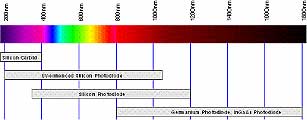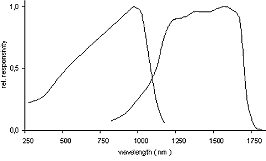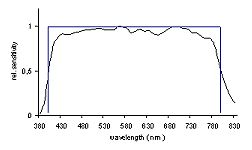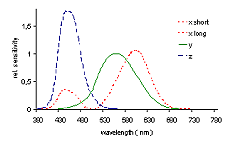III.2. Spectral sensitivity of an integral detector
Within the normal range of operation of an integral detector, the relation between the input signal (the spectral radiometric quantity to be measured) Xλ(λ) entering the detector and its corresponding output signal Y has to fulfil the following condition of linearity:
Let Y1 be the detector's response to the input signal Xλ1(λ) and Y2 the detector's response to the input signal Xλ2(λ). Then, the detector's response to the superimposed input signal Xλ1(λ)+Xλ2(λ) is given by Y1+Y2. Moreover, the detector's response is proportional to the input signal and therefore, the response to the input signal a·Xλ1(λ) is given by a·Y1 (whereby a denotes an arbitrary positive number). A detector might possibly show a certain dark signal Y0 (usually dark current or dark voltage), which is a nonzero output signal even when the detector is not exposed to any radiation at all. In this case, Y, Y1 and Y2 have to be replaced by Y-Y0, Y1-Y0 and Y2-Y0.
Link to applicable products: Calibration Services
Deviations from this behaviour are called nonlinearities and cause measurement errors. However, it is possible to experimentally determine a detector's nonlinearities and to correct for them. An example of a nonlinearity effect is the saturation of a detector's output signal at high radiation levels, which poses the upper limit of a detector's range of operation.
When nonlinearity effects can be neglected, the detector's output signal under arbitrary polychromatic radiation can be regarded as a superposition of the detector's output signals under monochromatic radiation. This leads to the concept of spectral sensitivity.
In detail, the CIE defines a detector's spectral sensitivity (also: spectral responsivity) s(λ) by

whereby Xλ(λ) denotes the spectral radiometric quantity defining the detector's input signal and dY denotes the (differential) increase of the output signal caused by the input radiation in the (differential) wavelength interval between λ and λ+dλ. When linear behavior of the detector can be assumed, the detector's signal Y is given by

Often, the spectral sensitivity function s(λ) is described by the product of a reference value sm and the relative spectral sensitivity sr(λ):
sr(λ) = sm · sr(λ)
In many cases, sm is given by the maximum of s(λ), thus sr(λ) is normalised to a value of 1 in its maximum. Another possibility is the normalisation of sr(λ) to a total wavelength integral value 1, which is achieved by the definition of

In terms of relative spectral sensitivity the detector's output signal Y is given by

This integral relation is equivalent to the definition of photopic quantities, whereby the detector's relative spectral sensitivity sr(λ) corresponds to the CIE spectral luminous efficiency function V(λ) and sm corresponds to Km = 683 lm/W (see § II.7.f). Similarly, the calculation of effective radiation doses relevant for certain biological reactions is based on a corresponding relation containing the respective biological action spectrum. For instance, the erythemal action spectrum is used for definition of Sunburn Unit, which is used for quantification of erythemally active solar UV irradiance (see § VI.1).
This correspondence allows the direct determination of photopic quantities or biologically active radiation by an especially designed integral detector. In particular, the detector's relative spectral sensitivity sr(λ) has to be matched closely to the CIE spectral luminous efficiency function V(λ) or to the respective action spectrum. For the determination of chromaticity coordinates or correlated color temperature, it is necessary to simultaneously use three detectors with their spectral sensitivities especially adapted to the color matching functions defined by the CIE 1931 standard colorimetric observer (see § II.10.a).
Gigahertz Optik uses different combinations of photodiodes and filters to achieve proper spectral sensitivities for detectors used in photometry, radiometry and colorimetry.
Link to applicable products: Light Detectors
III.2.a. Monochromatic radiometry
For radiometric characterisation of monochromatic or near monochromatic radiation of a known wavelength, a detector's spectral sensitivity does not necessarily have to match a certain predefined shape. Thus, a photodiode can be used without any spectral correction filters as long it is sensitive at the respective wavelength.


Fig. III.11. Sensitivity ranges of various types of photodiodes
Typical tasks of monochromatic radiometry are the laser power measurements, characterisation of LEDs with near monochromatic light output and power measurements in fibre optical telecommunication. Gigahertz Optik offers
• laser power meters equipped with a flat field detector (for lasers with collimated beams ) or with an integrating sphere (for lasers with non-collimating beams and LEDs),
Link to applicable products: LP-9901 or LP-9910 detector heads.
• integrating spheres equipped small area photodiodes, whose low capacitance results in a detector time constant in the order of nanoseconds. Thus, these detectors are perfectly suitable for laser pulse analysis with high time resolution.
Link to product: LPPA-9901 detector head.
• detectors equipped with integrating spheres with unique baffle design for measurements in fibre optics telecommunication. Additional adapters for standard fibre optic connectors are available.
Link to applicable products: UM Integrating Spheres.
III.2.b. Polychromatic radiometry
The determination of total radiation power over a certain spectral range requires the detector's spectral sensitivity function to closely match a rectangular shape.

Fig. III.12. Spectral sensitivity of Gigahertz Optik's RW-3702 VISIBLE400-800 nm Irradiance detector closely matches the ideal rectangular shape.
Gigahertz Optik offers absolutely calibrated irradiance and radiant power meters equipped with a cosine diffuser or an integrating sphere, whose spectral sensitivity is optimised for UVA, UVB, UVC, visible (VIS) and near infrared (NIR) ranges.
Link to applicable products: Light Detectors
III.2.c. Photometry
For photometric measurements, the detector's relative spectral sensitivity sr(λ) has to match the CIE spectral luminous efficiency function V(λ) as close as possible. In order to quantify a detector's inevitable spectral mismatch, the CIE recommends the evaluation index f1', which is defined by

where s*r(λ) is given by

where SA(λ) is the spectral distribution of the CIE standard Illuminant A (see § II.10.), which is the recommended photometric calibration source. High quality photometric detectors show a value for f1' below 3%, whereas a value of f1' above 8% is considered as poor quality. The DIN 5032, part 7 requires a spectral mismatch of f1' ≤ 3% for “Class A” instruments and f1' ≤ 6% for “Class B” instruments. Gigahertz Optik offers high quality illuminance, luminance and luminous flux detectors meeting Class A level (f1' = 3%) and, as an economical alternative, detectors meeting class B level (f1' = 5%).
Link to applicable products: Light Detectors
III.2.d. Colorimetry
For the determination of a color stimulus X, Y and Z values as defined by the CIE 1931 standard colorimetric observer, the same stimulus has to be measured by three different detectors, whose spectral sensitivity functions have to be adapted to the CIE 1931 XYZ color matching functions (see § II.10.a). However, as the  color matching function consists of two separated regions of sensitivity, the X value is often determined by two detectors. In this case, altogether four detectors are needed for the determination of a stimulus' X, Y and Z values. As the color matching function
color matching function consists of two separated regions of sensitivity, the X value is often determined by two detectors. In this case, altogether four detectors are needed for the determination of a stimulus' X, Y and Z values. As the color matching function  is identical with the CIE spectral luminous efficiency function V(λ), the respective detector can be absolutely calibrated for simultaneous photometric measurements.
is identical with the CIE spectral luminous efficiency function V(λ), the respective detector can be absolutely calibrated for simultaneous photometric measurements.
Gigahertz Optik's CT-3701 Precision Color Meter in combination with the P-9801 Optometer simultaneously provides absolute illuminance level, (x,y) and (u',v') chromaticity coordinates and correlated color temperature. As an economical alternative, Gigahertz Optik also offers the HCT-99 Hand-held Color Meter.

Fig. III.13. Spectral sensitivity functions used for colorimetric measurements with Gigahertz Optik's CT-3701 High Precision Color Meter.
Tutorials

